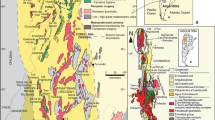Abstract
Stratigraphic investigations of the Vulsini Volcanic District indicate the existence of five prominent plinian fall deposits, deposited over a period of about 0.34 Ma. The oldest deposit (‘Basal pumices’) crops out mainly in the peripheral areas and is one of the largest plinian events in the Vulsini District, with a volume of about 9 km3 and a calculated column height exceeding 30 km. Subcircular patterns of isopachs and isopleths around the Bolsena lake indicate emplacement in wind-free conditions and suggest a source vent location in the northernmost sector of the present Bolsena lake, where it is possible that an older central volcanic structure existed. The four younger plinian fall deposits are related to Bolsena activity. The oldest of these, named the ‘Ponticello’ and ‘Orvieto-Bagnoregio’ pumices, are mainly distributed on the north-eastern sector of the Vulsini District. Their volumes are an order of magnitude lower than that of the basal unit, and the estimated column heights do not exceed 20 km. The younger ‘Ospedaletto’ pumice deposit has a NE-SW dispersal axis, whereas the youngest ‘Casetta’ pumice deposit is found only in the north-eastern sector of the district. Their estimated volumes are respectively 1.2 and 0.1 km3, whereas the inferred vent areas appear to be located slightly to the east of the Ponticello and Orvieto-Bagnoregio pumice deposit source areas. The chronology of the Ospedaletto and Casetta pumices indicates that the final plinian activity from the Bolsena complex is contemporaneous with the Latera activity. The decreasing volumes from the oldest to the youngest units, together with the progressive shifting northeastwards of the source vents, may be related to the volcano-tectonic subsidence of the Bolsena area. The source vents for the post-Basal pumices events are mainly clustered just north of Bolsena village where the greatest displacement during subsidence occurred. Accordingly, source vent shifting appears to be related to the progressive opening of normal faults from the inner to the outer margin of the Bolsena depression.
Similar content being viewed by others
References
Amodio M, De Rita D, Di Filippo M, Funiciello R, Galadini F, Sposato A (1987) Evoluzione geologico strutturale del bacino vulcano-tettonico di Bolsena (Complesso Vulcanico Vulsino). Boll GNV:21–36
Buonasorte G, Fiordelisi A, Pandeli E, Rossi U, Sollevanti F (1987) Stratigraphic correlations and structural setting of the pre-neoautochthonous sedimentary sequences of Northern Latium. Per Mineral 56:111–122
Capaccioni B, Nappi G, Renzulli A, Santi P (1987) The eruptive history of Vepe caldera (Latera volcano): a model inferred from structural and geochemical data. Per Mineral 56:269–283
Carey S, Sparks RSJ (1986) Quantitative models of the fallout and dispersal of tephra from volcanic eruption columns. Bull Volcanol 48:109–125
Cioni R, Sbrana A, Bertagnini A, Buonasorte G, Landi P, Rossi U, Salvati L (1987) Tephrostratigraphic correlations in the Vulsini, Vico and Sabatini volcanic succession. Per Mineral 56:137–155
Fierstein J, Nathenson M (1992) Another look at the calculation of fallout tephra volumes. Bull Volcanol 54:156–167
Inman DL (1952) Measures for describing the size distribution of sediments. J Sedim Petrol 22:125–145
Marini A, Nappi G (1986) Origin and evolution of the Montefiascone caldera (Vulsini Volcanoes). Mem Soc Geol Ital 35:657–665
Metzeltin S, Vezzoli L (1983) Contributi alla geologia del vulcano di Latera (Monti Vulsini, Toscana meridionale — Lazio settentrionale). Mem Soc Geol Ital 25:247–271
Nappi G (1991) Guida all'escursione sui depositi piroclastici del Distretto Vulsino. Progetti MURST 40%, Univ Urbino
Nappi G, Marini A (1986) I cicli eruttivi dei Vulsini orientali nell'ambito della vulcano-tettonica del complesso. Mem Soc Geol Ital 25:679–687
Nappi G, Chiodi M, Rossi S, Volponi E (1982) L'Ignimbrite di Orvieto nel quadro dell'evoluzione vulcano-tettonica dei Vulsini Orientali. Caratteristiche geologiche e tecniche. Boll Soc Geol Ital 101:327–342
Nappi G, Renzulli A (1990) Genesi ed evoluzione della caldera del Vepe (Complesso Vulcanico di Latera). Mem Descr Carta Geol d'Italia 38:129–144
Nappi G, Renzulli A, Santi P (1987) An evolutionary model for the Paleobolsena and Bolsena volcanic complexes: a structural and petrographical study. Per Mineral 56:241–267
Nappi G, Renzulli A, Santi P (1991) Evidence of incremental growth in the Vulsinian calderas (Central Italy). J Volcanol Geotherm Res 47:13–31
Nappi G, Capaccioni B, Renzulli A, Santi P, Valentini L. Stratigraphy of the Orvieto-Bagnoregio Ignimbrite eruption (Eastern Vulsini Volcanic District, Central Italy). Boll Serv Geol Ital, in press
Newhall CG, Self S (1982) The Volcanic Explosivity Index (VEI): an estimate of explosive magnitude for historical volcanism. J Geophys Res 87:1231–1238
Papale P, Rosi M (1993) A case of no-wind plinian fallout at Pululagua caldera (Ecuador): implications for models of clast dispersal, Bull Volcanol 55:523–535
Pyle DM (1989) The thickness, volume and grainsize of tephra fall deposit. Bull Volcanol 51:1–15
Santi P (1990) New geochronological data of the Vulsini Volcanic District (Central Italy). Plinius 4:91–92
Sparks RSJ (1975) Stratigraphy and geology of the ignimbrites of Vulsini volcano, central Italy. Geol Rundsch 46:497–523
Varekamp JC (1979) Geology and petrology of the Vulsinian volcanic area (Latium, Italy). Geol Ultraiectina 22, Utrecht p 384
Varekamp JC (1980) The geology of the Vulsinian area, Latium, Italy Bull Volcanol 43:487–503
Walker GPL (1971) Grainsize characteristics of pyroclastic deposits. J Geol 79:696–714
Walker GPL (1973) Explosives volcanic eruptions — a new classification scheme. Geol Rundsch 62:431–446
Wilson L, Sparks RSJ, Huang TC, Watkins ND (1978) The control of eruption column heights by eruption energetics and dynamics. J Geophys Res 83:1829–1836
Author information
Authors and Affiliations
Rights and permissions
About this article
Cite this article
Nappi, G., Capaccioni, B., Mattioli, M. et al. Plinian fall deposits from Vulsini Volcanic District (Central Italy). Bull Volcanol 56, 502–515 (1994). https://doi.org/10.1007/BF00302831
Received:
Accepted:
Issue Date:
DOI: https://doi.org/10.1007/BF00302831




